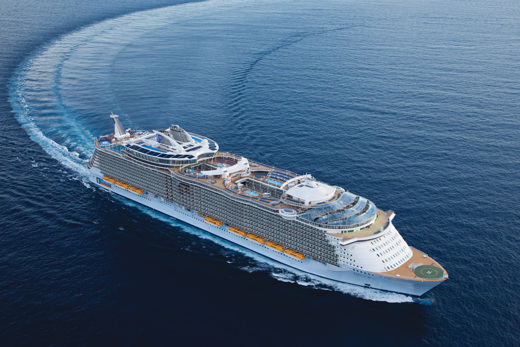
Koja Marine’s air conditioning systems onboard the Oasis of the Seas and Allure of the Seas are controlled by VACON® AC drives.
The Oasis of the Seas debuted in December 2009 as the world’s largest and most innovative cruise ship, featuring many cruise industry firsts. Energy efficiency and a low carbon footprint per passenger were central design criteria. The figures are impressive.
The Oasis of the Seas is a massive, 361-metre-long (1187 ft) floating wonderland offering ‘WOW’ experiences. The Oasis is bigger and more versatile than its predecessors, but has still improved its overall energy efficiency by 15 % to 25 % and has a low carbon footprint per passenger. “We consider that the energy efficiency per passenger of the Oasis is some 50 % better than the average 10-year-old cruise ship,” says Harri Kulovaara, Executive Vice President at Royal Caribbean Cruises Ltd. (RCCL). “The benefits of scale are naturally one aspect, but the important thing is to realize how focused work in each area of energy consumption can lead to enormous savings,” he says.
Innovative HVAC solutions improve overall efficiency
After propulsion, HVAC (heating, ventilation and air-conditioning) is one of the main energy consumers onboard, accounting for roughly 30 % of the energy consumed. So a sophisticated HVAC monitoring and control system was designed for the Oasis, utilizing extensive expertise and knowhow. The ship owner reports savings of close to 30 %.
The entire air-conditioning systems onboard the Oasis and its sister vessel the Allure of the Seas to be launched in October 2010 are the result of a major cooperation project, with Finland-based Koja Marine as the main contractor. Koja Marine is known as a supplier of air conditioning systems to the world’s most exclusive cruise liners, and RCCL had asked the company back in 2004 to present its latest ideas and technologies for an optimized system.
Utilizing its extensive experience in advanced land-based installations, Koja Marine designed an energy-efficient system that provides maximum passenger comfort but occupies a small system footprint, so as to maximize the passenger areas and minimize the technical areas. The design of the HVAC plant, for instance, has been improved by moving many of the fan-coil cooling elements out of the air conditioning room and closer to the public areas, and modern technology is used to control air flows. The Oasis uses the latest AC room technology, with direct driven, frequency-controlled fans in the air-handling units and stainless steel casings, minimizing energy consumption and the need for service.
VACON® AC drives control temperature and humidity
The need for air-conditioning onboard varies depending on the specific function in an area and the number of passengers present. The 350 VACON® AC drives are a key technology that help Koja Marine meet this challenge, providing stepless speed control of the fan coil units.
VACON® AC drives control the temperature, ventilation and level of humidity in the public areas, ensuring better air quality onboard. The level of carbon dioxide is measured in public areas, and the operation of the fan coils is adjusted accordingly with the help of VACON® AC drives, resulting in optimized energy consumption.
Vacon® AC drives are silent when operating since they require no large built-in fans, so the air conditioning system does not cause any disturbing noise. All this adds to passenger and personnel comfort.
The wide selection of factory-ready applications in the VACON® AC drives was a major benefit in the Oasis project. “The versatility of the applications enabled a wide use of the AC drives in various process control and monitoring tasks on the Oasis. A number of the field I/Os are connected to the VACON® I/O board: some are used for the vessel’s automation via the Profibus fieldbus and some for controlling the AC drives when the air-handling unit is controlled locally,” Mr Nousiainen explains.
Fan control via Profibus
The Oasis of the Seas is the first cruise liner where the VACON® AC drives are connected to the air conditioning system via Profibus. The fieldbus technology reduces the amount of wiring and the number of connections, cuts the costs for installation, commissioning and service, and makes the system more resistant to malfunctions.
The fieldbus technology also offers almost unlimited possibilities for control commands and access to a wide range of measurement and control data on the process itself. Mr Nousiainen gives a practical example that directly relates to energy efficiency. “The Profibus fieldbus provides access to motor power values. The ship owner is therefore able, in real time, to monitor the amount of energy used by the process. Changes made by a passenger to the values in the HVAC automation system and their effect on energy consumption can be perceived instantly.”
Long-term cooperation with Koja Marine
Since 2000, Vacon has supplied Koja Marine with thousands of AC drives that control the fans in Koja’s air conditioning systems used onboard some 20 luxury cruise liners — most of which are sailing in the Caribbean. Vacon’s scope of delivery to Koja Marine includes air-cooled AC drives up to 50 kW, mainly 380 − 500 V units in IP54 enclosures, providing a high degree of protection against humidity.
Working closely together, Koja Marine and Vacon have demonstrated their ability to provide reliable, high-performance and energy-efficient air conditioning technology to the marine and offshore industries, one of the most challenging sectors. “Cooperation with Vacon, during the Oasis project but in general as well, has gone well,” says Koja Marine Director Esko Nousiainen. “
He also appreciates the reliability of the drives and the technical support and service provided by Vacon. “The VACON® AC drives have operated reliably, and Vacon has resolved the minor problems that have occurred over the years quickly and in a spirit of cooperation. AC drive deliveries have caused no delays in commissioning our HVAC systems,” Mr Nousiainen concludes.
Please note that Vacon joined the Danfoss Group in December 2014.
Get more information
Read the case story and download
Read more about Marine and Offshore
